Physical Address
304 North Cardinal St.
Dorchester Center, MA 02124
Eyelid lesions can originate from any layer or structure within the eyelid and surrounding adnexa.
Benign eyelid tumors are often diagnosed based on a characteristic appearance.
Eyelid lesions in children can cause amblyopia and should be monitored closely.
Vascular eyelid lesions are increasingly being treated with nonsurgical approaches.
A biopsy should be performed if an eyelid lesion is not easily diagnosed based on clinical appearance or if the lesion undergoes changes.
Numerous benign tumors and related noninfectious, noninflammatory lesions arise from the varied structures composing the eyelid. The lesions discussed in this chapter are classified according to the structure of origin: epidermis, dermis, and eyelid adnexa. Melanocytic lesions are described separately. Many benign eyelid lesions may appear elsewhere on the body as cutaneous lesions. However, when present in the eyelids, their appearance and behavior may differ, due in part to the unique characteristics of the eyelid skin and anatomy. Other eyelid lesions may represent manifestations of systemic disease.
Eyelid skin is the thinnest skin of the body, averaging 0.1 mm in thickness, and becomes thinner with advancing age. Upper eyelid skin is thinner than lower eyelid skin. This thin skin extends a short distance beyond the orbital rim. Eyelid skin consists of a keratinized epidermis overlying a poorly defined papillary dermis, which is void of rete ridges. The dermis is separated from the underlying orbicularis oculi muscle by a very thin areolar subcutaneous connective tissue layer devoid of fat.
The epidermis is composed of two cell types: keratinocytes and dendritic cells. Keratinocytes are arranged in four layers from deep to superficial: the basal, squamous, granular, and horny cell layers.
The basal cell layer consists of a single row of column-shaped cells that lie on a basement membrane, which is firmly attached to the underlying dermis. The basal layer generates the more superficial layers of the epidermis. The basal keratinocytes contain a variable amount of melanin pigment derived from the adjacent dendritic melanocytes. The degree of skin pigmentation is thus dependent on the amount of pigment present.
The squamous cell layer consists of polygonal cells arranged in a mosaic pattern, usually 5–10 layers thick. The cells become more flattened as they mature and migrate toward the skin surface.
The granular cell layer, also called the prickle cell layer, consists of a row of elongated, flattened cells. The cytoplasm of the granular cells is filled with basophilic keratohyalin granules.
The horny cell layer consists of flat, anuclear, keratinized cells.
The basal keratinocytes are undifferentiated. As they divide, the cells either remain in the proliferative pool or begin to differentiate. As the cells differentiate, they migrate toward the surface, flatten, and lose their nuclei. This process terminates as cell death in the superficial horny layer, where keratinization occurs.
The second cell type of the epidermis is the dendritic cell. Three types of dendritic cells are present in the epidermis: clear cell melanocytes, Langerhans cells, and undetermined dendritic cells. Histochemistry and electron microscopy are necessary to identify the Langerhans and undetermined cell types.
The epidermal adnexa of the eyelids include the pilosebaceous unit and the eccrine and apocrine sweat glands. The pilosebaceous unit consists of the eyelid cilia and associated sebaceous glands of Zeis. Sebaceous glands are holocrine glands; thus their acini possess no lumina and secretion is via decomposition of their cells. Sebaceous glands may develop from the external root sheath of the hair follicle and empty into the hair follicle. Alternatively, as in the case of the meibomian gland, glandular elements may develop from the epidermis and empty at the skin surface. The meibomian gland is composed of several lobules leading to a common secretory duct.
Eccrine and apocrine glands are the two distinct types of sweat glands in humans. Eccrine sweat glands are independent of the hair follicle apparatus. They are found everywhere on the skin surface except the vermilion border of the lip, the glans penis, and the nail bed. Eccrine glands hypersecrete, mainly in response to thermal stimuli, and thereby aid in thermoregulation. However, eccrine glands of the axillae, palms, and soles also hypersecrete in response to emotional stimuli. Eccrine glands contain both secretory and ductal components. The secretory cells of the gland are located in the dermis. The ductal cells are located in the dermis and epidermis and function to transport sweat to the skin surface. A wide variety of tumors originate from the pluripotential cells, which normally differentiate into the various components of the eccrine sweat gland unit.
Apocrine sweat glands serve no useful purpose in humans, functioning only as scent glands. The apocrine eyelid glands are the glands of Moll, which are active only in the years between puberty and senescence. As in the case of sebaceous glands, they are influenced by circulating androgens. Emotional stimuli, mediated through the sympathetic nervous system, stimulate gland secretion. Apocrine glands are larger than sebaceous glands and lie deeper in the skin. They are simple tubular glands that often open above a sebaceous gland orifice in the hair canal. Like the eccrine sweat glands, they have both secretory and ductal components. The sweat from these glands is formed by decapitation and extrusion of the secretory cell cytoplasm into the gland’s lumen. The sweat is then transported to the skin surface by ductal cells. Tumors of apocrine sweat gland origin are common. Histopathologic examination is frequently required to differentiate between the various benign tumors of the apocrine sweat gland apparatus.
Hair follicles present in the eyelid include the eyelashes and the vellus hairs of the skin. Eyelashes are terminal hair follicles. Vellus hairs cover the remaining skin of the eyelid and are associated with sebaceous glands.
The dermis of the eyelid is composed of bundles of collagen, variable amounts of elastic and reticulin fibers, and ground substance containing mucopolysaccharide. Nerve fibers, blood vessels, and lymphatics course through the dermis.
Many benign tumors of the eyelids may be readily diagnosed on the basis of characteristic clinical appearance, location, and behavior. Some tumors require biopsy for reliable and definitive differentiation from malignant tumors. Two studies examining the accuracy of clinical diagnosis of eyelid lesions have been reported. One of these found that 1.9% of presumed benign lesions proved to be malignant after histopathologic examination; the sensitivity of clinical diagnosis of malignancy was 89.7% and the specificity 98.2%. The other study found that 4.6% of presumed benign lesions proved to be malignant; the sensitivity of clinical diagnosis of malignancy was 87.5% and the specificity 81.5%. These studies led to the recommendation that all lesions, no matter how apparently benign, should be examined histopathologically.
An incisional biopsy is performed by excising a representative portion of the lesion for histopathologic evaluation. This technique is employed for large lesions. In cases of small tumors, an excisional biopsy may fulfill both diagnostic and treatment goals. Any complete excisional biopsy must include adjacent normal tissue on all margins. The shave biopsy technique is indicated for lesions involving only the epidermis or upper dermis (e.g., seborrheic keratosis). Shave biopsies are inadequate for pigmented lesions and in cases necessitating differentiation between a keratoacanthoma and squamous cell carcinoma.
Microscopic control with surgical tumor excision can be achieved by either the Mohs fresh-tissue tumor resection technique or frozen-section controlled excision. In the Mohs technique, the lesion is shaved into thin sections that are evaluated microscopically. The advantage of this technique, which is especially useful for eyelid lesions, is maximum preservation of normal tissue. In the frozen-section control method, the lesion and a 3- to 6-mm margin of normal-appearing tissue are resected, depending on the type of tumor. The margins are then evaluated microscopically by a pathologist to confirm the presence or absence of tumor. If margins are positive for tumor presence, additional tissue is resected and analyzed until the margins are free of tumor.
The majority of the benign lesions discussed in this chapter are most appropriately managed by observation or surgical excision. Lesions necessitating alternative treatment modalities are discussed separately.
As discussed earlier, there are four types of keratinocytes and three types of dendritic cells. Benign epidermal lesions may arise from any of these various cell types in the epidermis. Lesions are classified and discussed according to epidermal cellular origin. The majority of the lesions described exhibit benign characteristics. Features of malignant transformation include a rapid and asymmetric growth pattern, ulceration, itching, pain, color change, and bleeding. Lesions exhibiting any of these characteristics should always be biopsied to rule out malignancy.
Acrochorda, also called skin tags ( Fig. 27.1 ), are common benign eyelid tumors. Clinically, they appear as small, multiple, flesh-colored lesions attached to the eyelid margin or skin by a thin pedicle. Occasionally they may be large and pedunculated. These tumors are often ambiguously referred to as papillomata, a descriptive yet nondiagnostic term used to describe many cutaneous lesions with various histopathologic diagnoses. A common variant is verruca vulgaris, which is an infectious lesion.
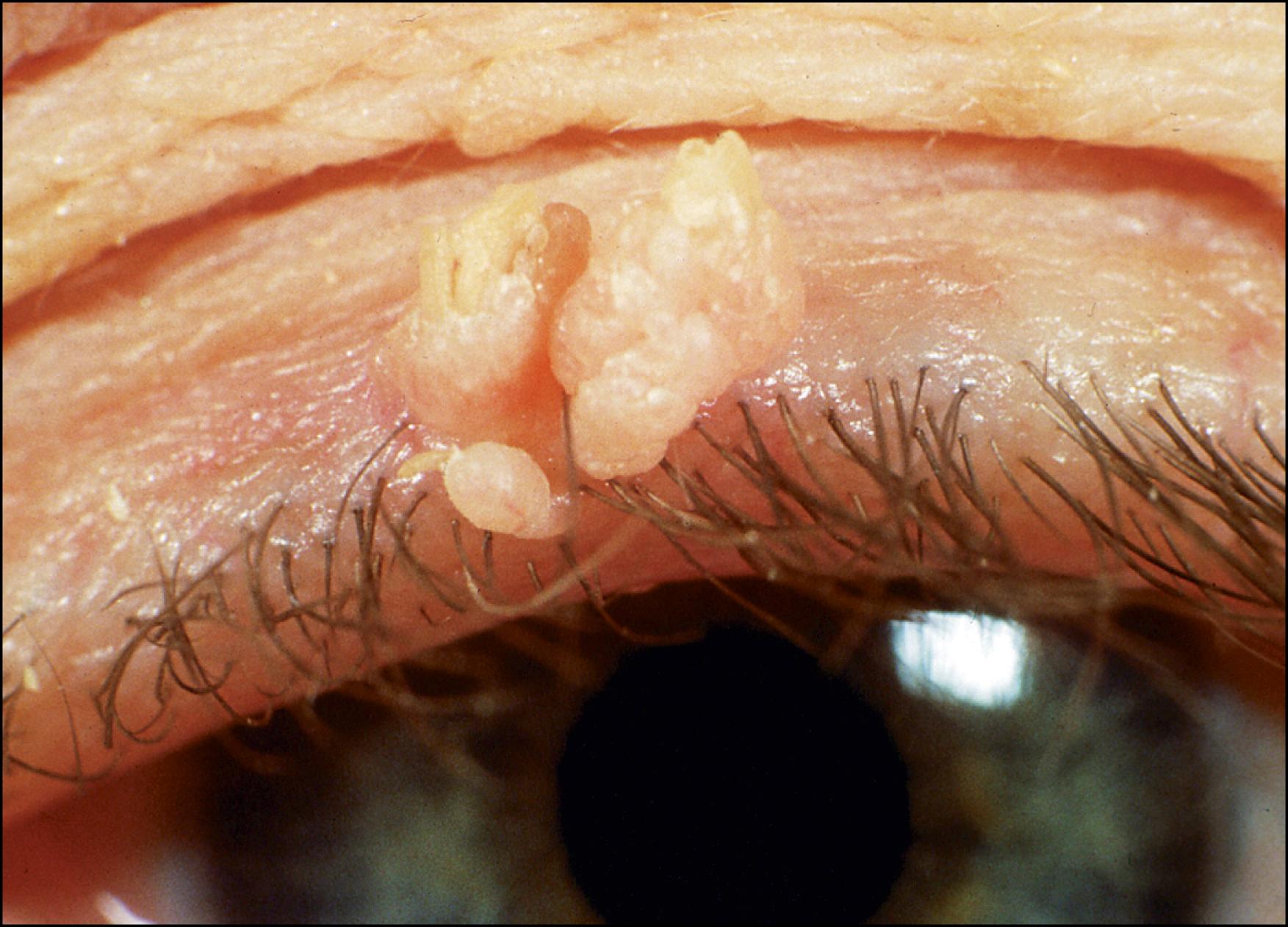
Histopathologically, acrochorda are characterized by thickening of the squamous cell layer (acanthosis) and the keratin layer (hyperkeratosis) without loss of polarity or cellular atypia.
Treatment consists of simple surgical excision of the lesion with a sample of the base included. This is easily performed with scissors or scalpel. Hemostasis is easily achieved with handheld cautery or gentle pressure. Sutured closure is usually not necessary.
This lesion (sebaceous cyst, epidermoid cyst) arises from the infundibulum of the hair follicle. It may occur spontaneously or as a sequela of surgical or traumatic implantation of epidermal tissue into the dermis. Multiple facial inclusion cysts may be seen in patients with Gardner syndrome, an autosomal dominant disorder characterized by intestinal polyps; multiple facial bone osteomas; fibromas and epithelial inclusion cysts of the skin; fibromatosis (dermoid tumors) of the abdominal wall, mesentery, and breasts; and multiple lesions consistent with congenital hypertrophy of the retinal pigment epithelium (CHRPE). Mutations have been demonstrated in the APC gene in patients affected by this disease. , This slow-growing, elevated, round, smooth, firm, keratin-filled lesion rarely exceeds 1 cm in diameter ( Fig. 27.2 ). It is often attached to the overlying, thinned skin by the remaining pilar duct, which may appear as a pore. Rupture of the cyst may cause a foreign body reaction, with the cyst becoming secondarily infected. Malignant degeneration is extremely rare.
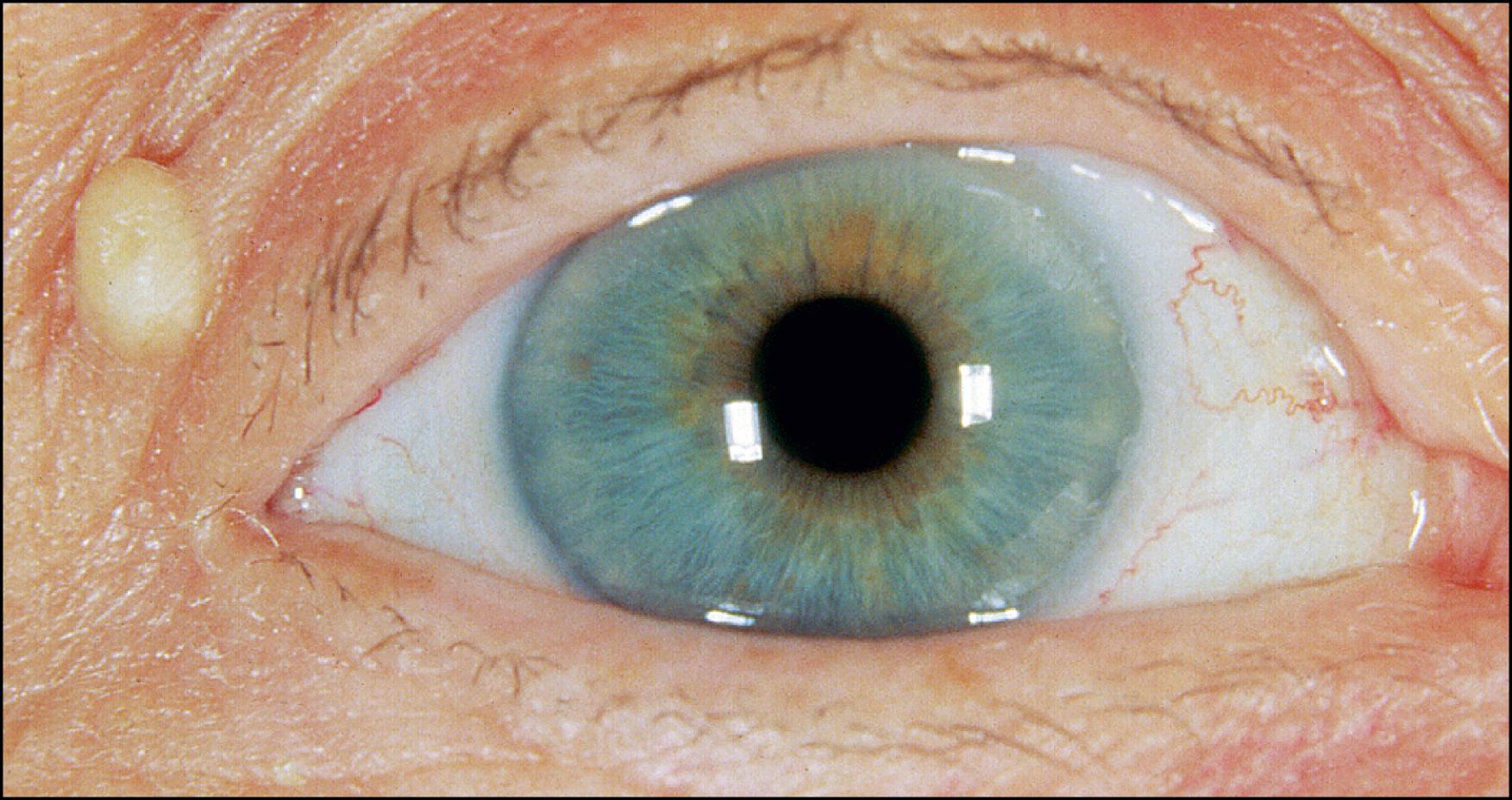
Recommended treatment is marsupialization or, if possible, complete excision of the cyst without violation of the cyst wall.
Seborrheic keratoses are commonly acquired eyelid lesions affecting middle-aged and elderly patients. Clinical appearance varies considerably in terms of size and degree of pigmentation. This variability makes differentiation from nevi, pigmented basal cell carcinomas, and melanoma difficult in some cases ( Fig. 27.3 ). Single or multiple lesions may be present, and hyperpigmentation is common. The lesions have a different appearance when present on the eyelids versus elsewhere on the face. Facial lesions appear smooth and greasy, with elevated well-demarcated borders producing a classic “stuck on” appearance. Eyelid lesions appear lobulated, papillary, or pedunculated, with friable cerebriform excrescences on the surface ( Fig. 27.4A ). A sudden eruption of multiple seborrheic keratoses may be a cutaneous manifestation of internal malignant disease (Leser-Trélat sign). A heavily pigmented variant with multiple lesions seen in black individuals has been termed dermatosis papulosa nigra.
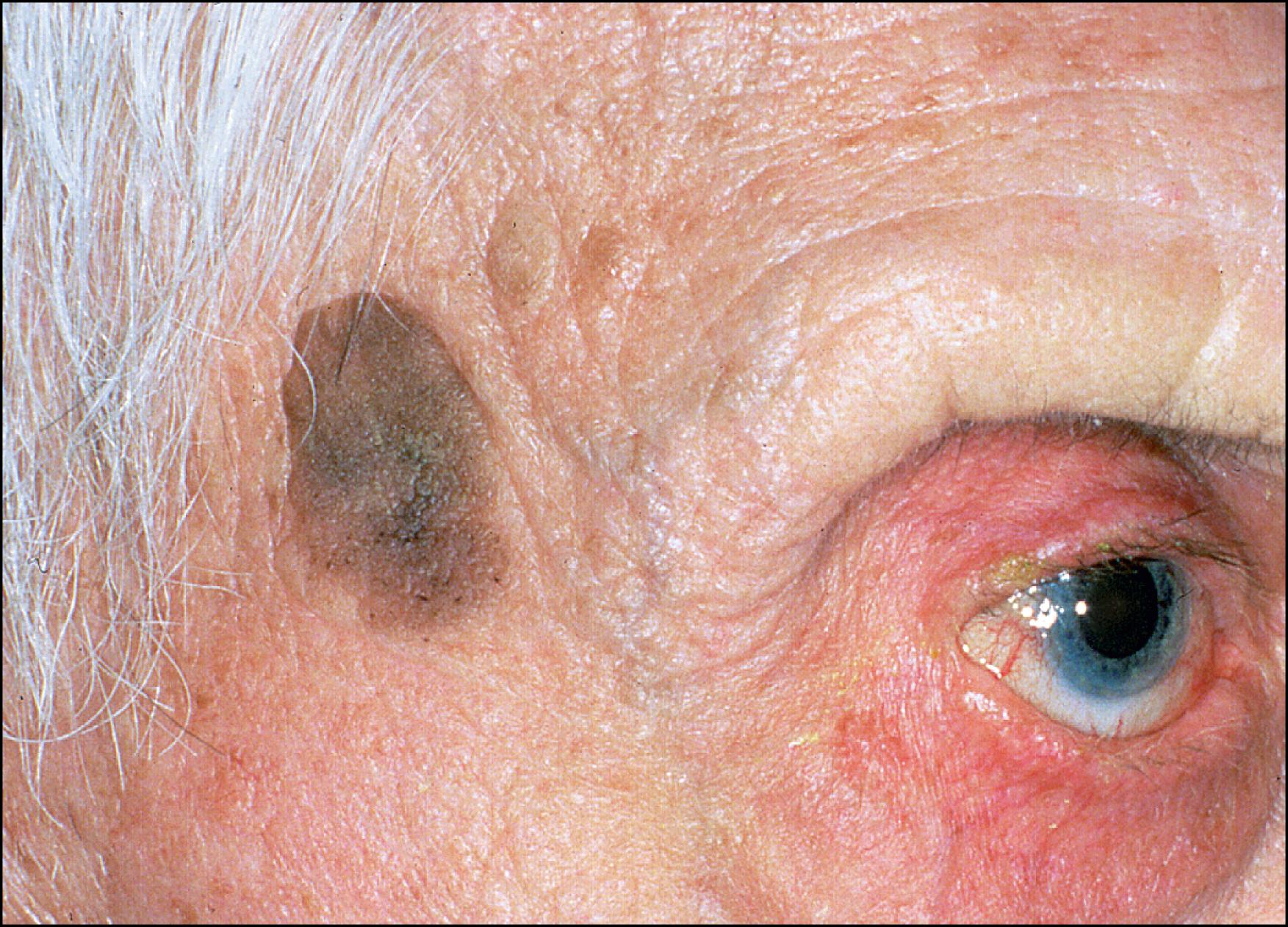
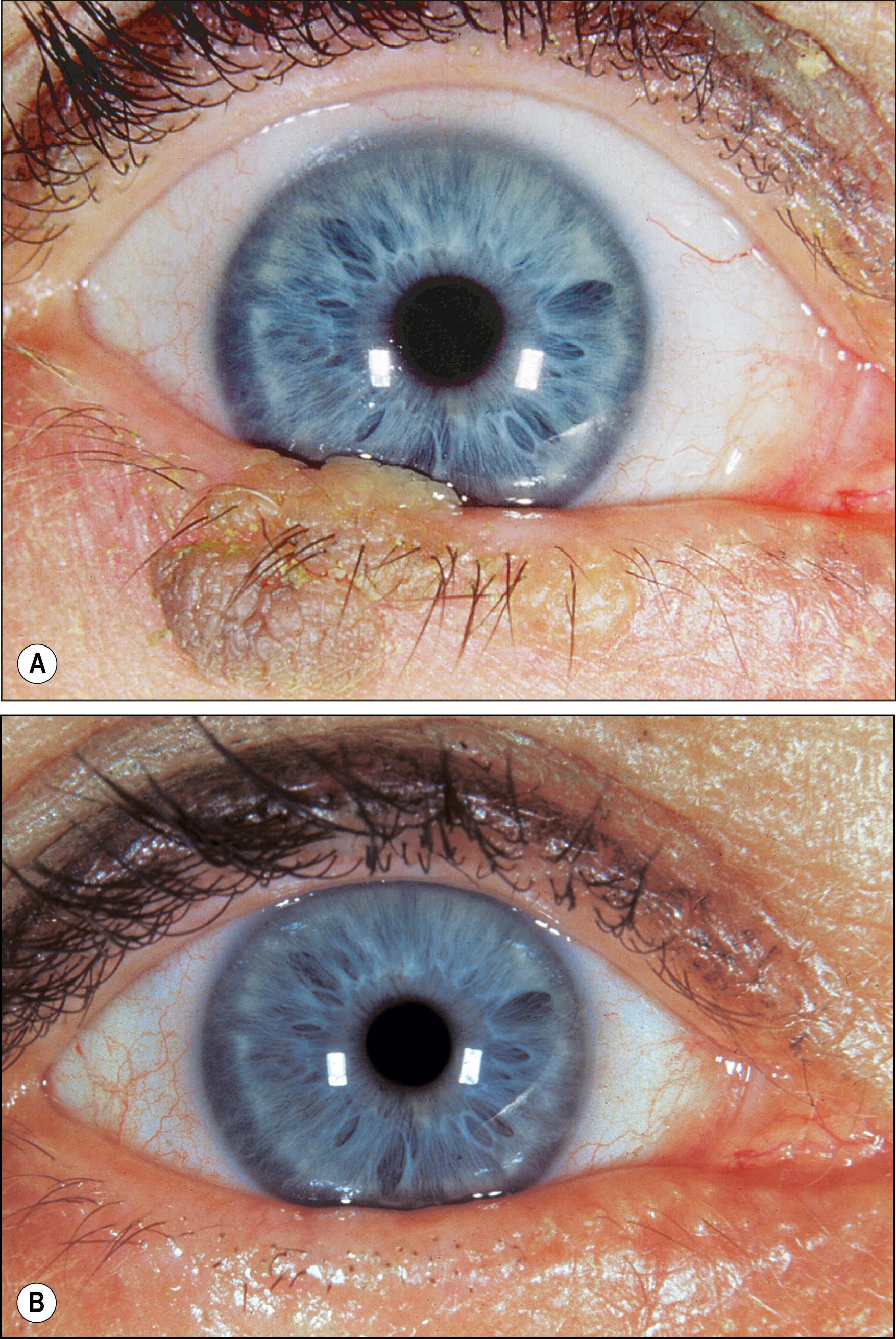
Seborrheic keratoses are divided into three major types according to the predominant histologic features: hyperkeratotic, acanthotic, and adenoid. Variable degrees of hyperkeratosis and acanthosis are observed in all three. The acanthotic epidermis often contains keratin-filled cystic inclusions. These are referred to as “horn cysts” when they form within the mass and “pseudo–horn cysts” when they represent invaginations of surface keratin. Melanin may be abundant in keratinocytes, especially in the adenoid and acanthotic forms. The dermis is uninvolved except in irritated seborrheic keratoses, in which case it is infiltrated by chronic inflammatory cells.
Surgical excision involves shaving the lesions from the skin surface with a scalpel ( Fig. 27.4B ). Although some lesions are large, the growth pattern is superficial and deep excision is unnecessary. The residual flat surface reepithelializes rapidly.
Milia are small, raised, round, white, sharply circumscribed cystic lesions of the eyelids. Usually asymptomatic, milia may arise spontaneously, following trauma, in areas of previous radiation, or appear during the healing phase of a bullous disease process. They are particularly common in newborn infants. Histopathologically, these lesions are superficial keratin cysts.
Treatment consists of incision of the overlying skin with a sharp blade or needle and expression of the contents.
Previously, keratoacanthoma was considered a benign self-limiting lesion. Many authors now regard the tumor as a low-grade squamous cell carcinoma. Although trauma and sunlight exposure have been implicated in its pathogenesis, the exact etiology remains unknown. Immunosuppressed patients also exhibit increased risk. Middle-aged or elderly patients are typically affected. Although commonly solitary, cases involving multiple lesions have been described. Their distinctive clinical appearance and behavior aid in diagnosis. The lesion usually begins as a small flesh-colored papule on the lower lid that develops rapidly over the course of a few weeks into a dome-shaped nodule with a central keratin-filled crater and elevated, rolled margins ( Fig. 27.5 ). Clinically, the lesion often resembles a nodular ulcerative basal cell carcinoma. Gradual resolution over the course of approximately 3–6 months ensues, and visible sequelae are rare.
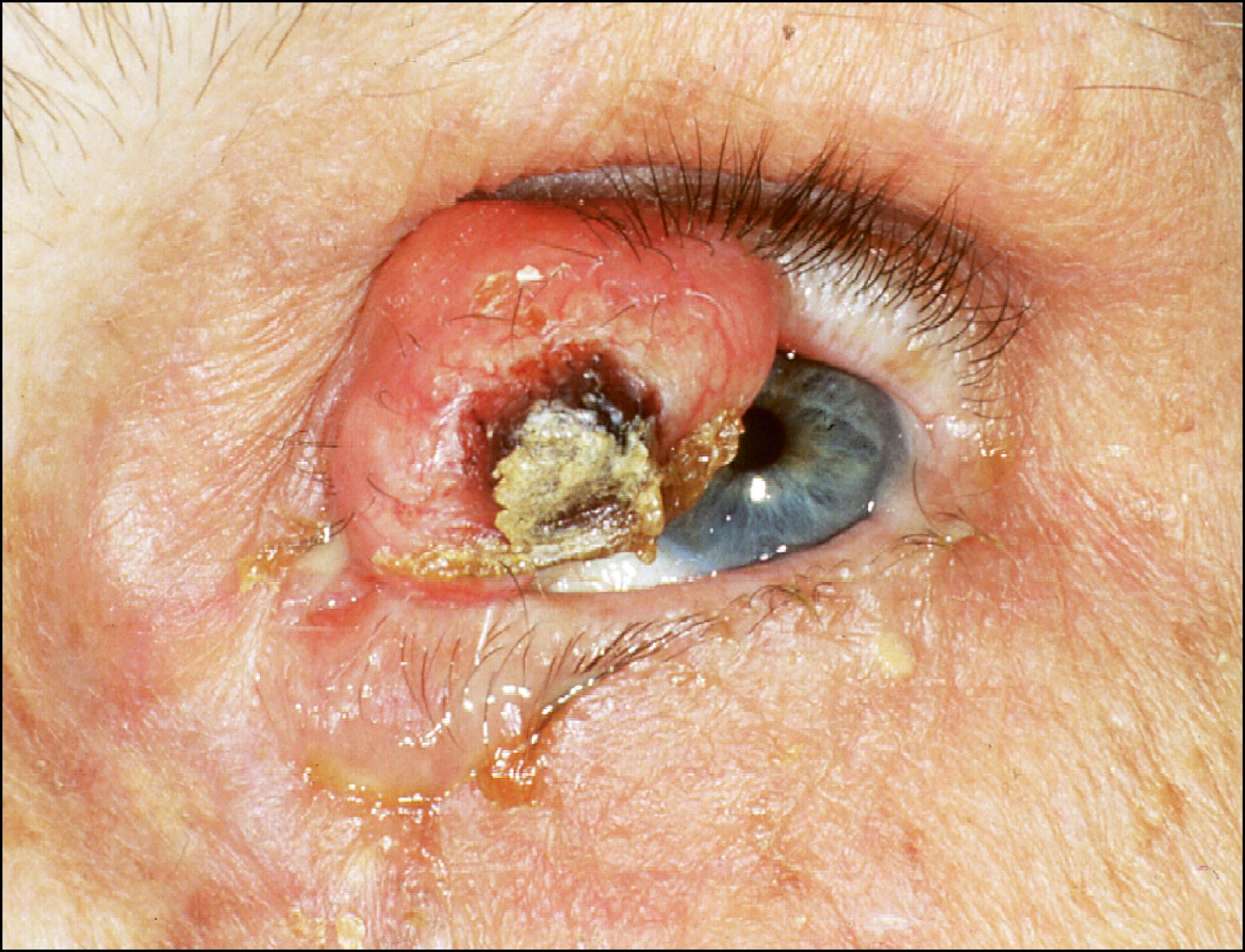
Muir-Torre syndrome is an autosomal dominant disorder in which individuals have a predisposition toward keratoacanthoma, benign and malignant sebaceous tumors, and visceral malignancies. The syndrome is part of the Lynch cancer family syndrome II, which is associated with mutations in the MSH2 and MLH1 genes.
Ferguson-Smith syndrome (multiple self-healing squamous epitheliomas) is an autosomal dominant condition in which multiple keratoacanthomas are observed. Linkage to 9q31 has been demonstrated.
Histologically, a keratoacanthoma typically has a cup-shaped nodular elevation with thickening of the epidermis. The epidermis contains islands of well-differentiated squamous epithelium surrounding a central mass of keratin. Microabscesses may be present within the islands of squamous epithelium. The dermis shows a polymorphous inflammatory infiltrate.
Although keratoacanthomas are usually self-limited, the prolonged healing period and potential delay in treatment of a possible misdiagnosed malignancy are reasons to pursue a more definitive treatment strategy.
After incisional biopsy confirms the diagnosis, complete surgical excision is the recommended treatment. Large, aggressive lesions have been treated with radiotherapy. Alternative treatment modalities include cryotherapy, intralesional methotrexate, and topical or intralesional 5-fluorouracil.
Pseudo-epitheliomatous (pseudo-carcinomatous) hyperplasia is a condition often seen in areas of cryosurgery or surgical wounds. It is commonly associated with chronic inflammation and shows an active proliferation of epidermoid or squamous cells that develop into a hyperkeratotic nodule on the skin surface. Keratoacanthoma is considered to be a variant of pseudo-epitheliomatous hyperplasia.
The clinical presentation of inverted follicular keratosis may vary. Nodular, papillomatous, verrucous, and cystic forms occur. The lesion is usually solitary, and hyperpigmentation is rare. Although the etiology is unknown, it is generally considered a form of irritated seborrheic keratosis.
The term inverted follicular keratosis describes the histopathologic features of this lesion. Epithelial lobular acanthosis with overlying hyperkeratosis and occasional central keratin-filled, cup-shaped invagination is observed. There is a proliferation of uniform basaloid cells with an abrupt transition to concentrically arranged squamoid cells. The dermis is uninvolved.
Treatment is surgical excision.
Cutaneous horn is a clinically descriptive nondiagnostic term. This lesion may be associated with a variety of benign or malignant lesions, including seborrheic keratosis, verruca vulgaris, and squamous or basal cell carcinoma.
Treatment should be directed at the underlying cutaneous lesion. Biopsy of the base of the cutaneous horn is required to establish a definitive diagnosis. Simple excision of the horn itself provides insufficient tissue for accurate diagnosis.
A linear epidermal nevus may be solitary and localized or multiple and part of the systemic epidermal nevus syndrome. The lesion consists of multiple closely set, papillomatous, hyperkeratotic papules. Lesion color varies with the degree of pigmentation and hyperkeratosis. Individuals affected with the epidermal nevus syndrome may have associated skeletal deformities and central nervous system CNS disorders.
Surgical excision is usually curative. Alternate therapeutic modalities include cryotherapy, electrodesiccation, dermabrasion, and topical treatment with retinoic acid.
This condition occurs in the sun-damaged skin of older, fair-skinned Caucasians. Multiple comedones and yellow nodules with central comedones occur most commonly near the lateral canthus and extend to the malar eminence and temple. The eyelid and facial skin often reveal other signs of actinic damage. Actinic comedonal plaque is a variant of this condition, in which a solitary plaque with small nodules, dilated follicles, and numerous underlying comedones occurs on the eyelid and facial skin.
Treatment includes topical retinoic acid and mechanical removal of the cysts and comedones.
Damage to the epidermal cells of the skin by ultraviolet radiation may result in actinic or solar keratoses. Fair-skinned older patients with a history of sun exposure of significant duration are typically affected. Lesions are multiple and affect the face, scalp, forearms, and backs of the hands. The lesions have a yellow-brown or erythematous color, an oval shape, and a white scale. They may occur anywhere on the eyelids ( Fig. 27.6 ). Although they may be precursors to squamous cell carcinoma, mitotic activity is low and metastases are rare. Individuals with xeroderma pigmentosum have a predisposition to actinic keratoses and malignancies of the skin. This is an autosomal recessive condition due to a defect in repair of UV light–induced damage to the DNA of epidermal cells. There are at least four different genetic loci.
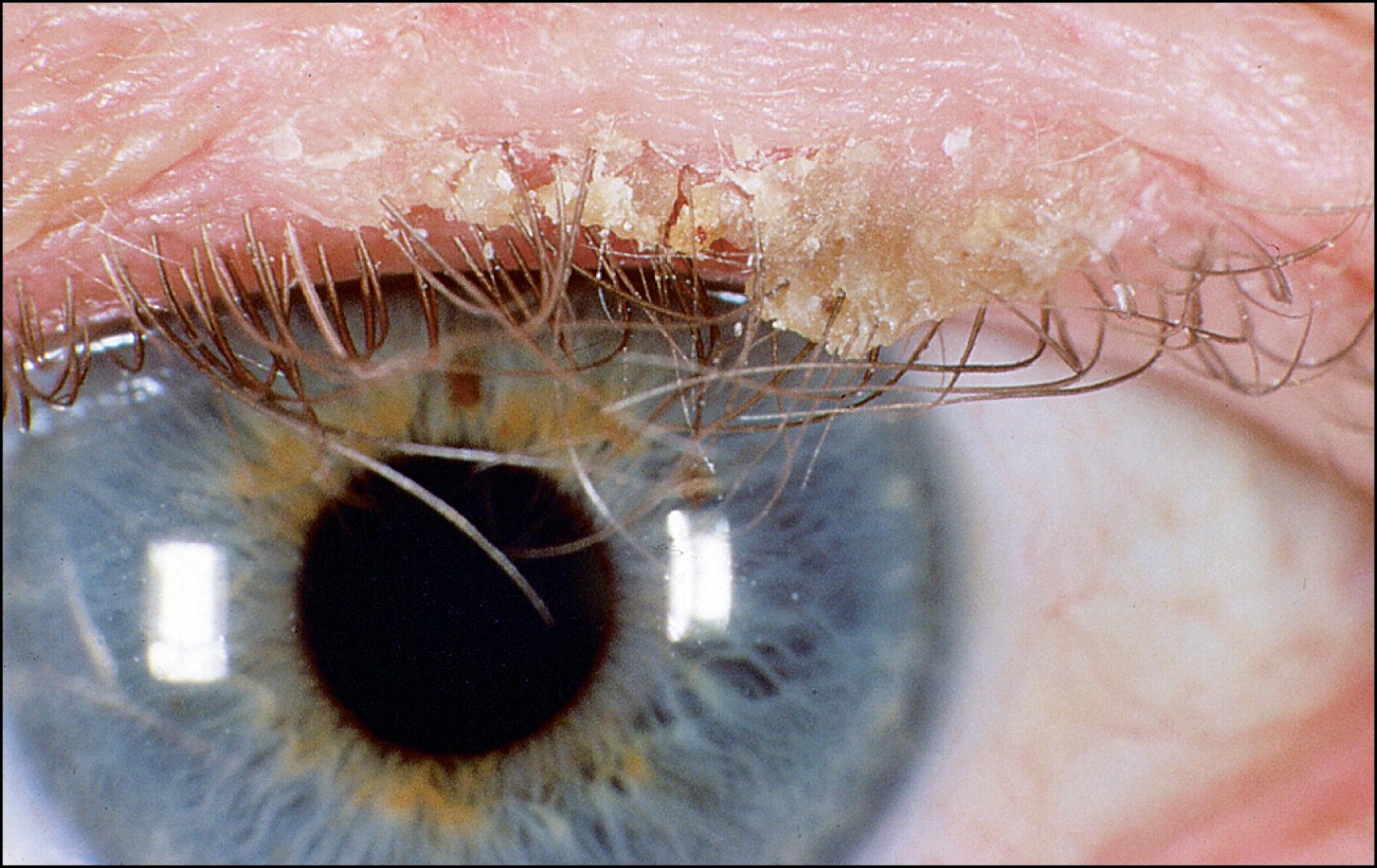
Histopathology of actinic keratoses shows hyperkeratosis, irregular acanthosis, focal parakeratosis, dyskeratosis, focal atrophy, and atypical keratinocytes.
Treatment modalities include topical liquid nitrogen, electrodesiccation, topical imiquimod, and topical fluorouracil.
Dermoid and epidermoid cysts are choristomas that occur as a result of the sequestration of ectoderm along the lines of embryonic closure. They contain dermal and epidermal elements, respectively. Both cyst walls are lined by keratinizing epidermis. Dermoid cyst walls also contain dermal appendages, including sebaceous glands, sweat glands, and hair follicles. Secretions from contained sebaceous and sweat glands fill the cyst and cause a gradual increase in its size. In comparison, epidermoid cysts are filled with keratin.
Although such cysts are present at birth, their clinical presentation may not occur until later in life. The lateral brow and upper lid adjacent to the frontozygomatic suture are the most common locations ( Fig. 27.7 ). Dermoid cysts presenting medially at the nasofrontal suture in the orbit must be differentiated from a meningocele or a meningomyelocele. A large dermoid cyst may compress the globe and cause astigmatic amblyopia. Deprivation amblyopia may be caused by a dermoid-induced mechanical ptosis. Extension into the orbit is not uncommon, and large cysts may extend into the cranial vault. Rupture of the cyst releases irritating secretions, which may cause a severe inflammatory reaction. Rupture should be treated intraoperatively with copious irrigation and postoperatively with corticosteroids.
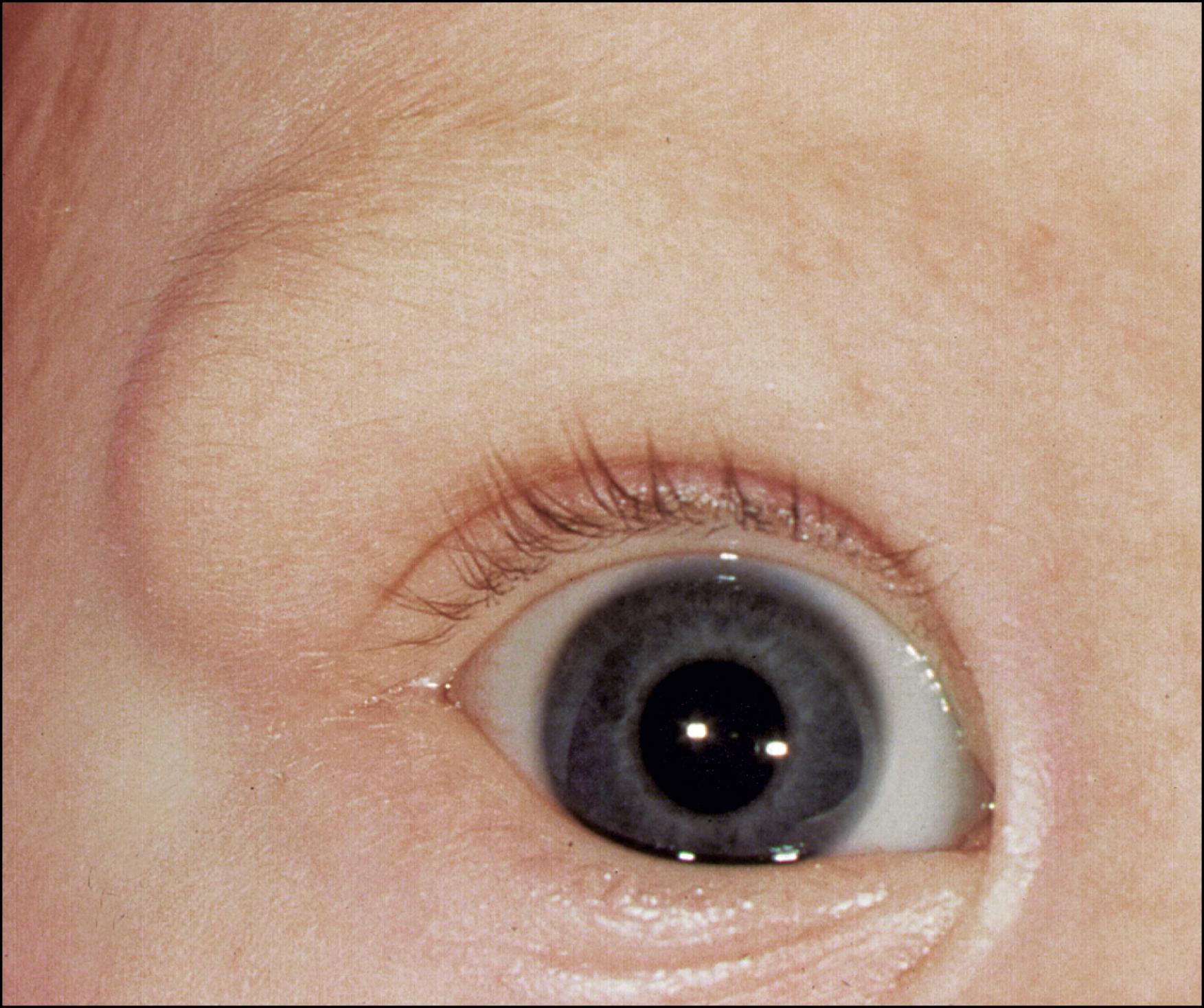
Histologically, the dermoid cyst wall is lined with a stratified squamous epithelium. The cyst wall typically possesses dermal appendages including sebaceous and eccrine sweat glands that secrete directly into the lumen of the cyst. Hairs contained in the cyst wall project into the cyst lumen.
Recommended treatment is complete surgical excision without rupture of the cyst wall. Indications for surgical resection include clinical evidence of manifest or threatened amblyopia or cosmetic deformity. Radiologic imaging with computed tomography (CT) and magnetic resonance imaging (MRI) is indicated when the entire extent of the cyst cannot be palpated, in the setting of proptosis, or when significant orbital or intracranial extension is suspected. The lesion is nonenhancing and well circumscribed.
Oncocytoma is a rare tumor composed of oncocytes or large eosinophilic cells that grow in an adenomatous pattern. Oncocytes are thought to be epithelial cells that undergo transformation with aging. Although the majority of oncocytomas arise from the caruncle, they may also occur at the mucocutaneous border of the eyelid, the lacrimal sac, or the conjunctiva. Rare in patients under the age of 60 years, this benign tumor exhibits slow growth. It rarely exceeds 15 mm in diameter; the color varies from red to yellow, and the surface may be smooth or lobulated. ,
Treatment is surgical excision.
Phakomatous choristoma is a rare lesion believed to be a congenital neoplasm of lenticular anlage. The anteroinferior aspect of the medial lower eyelid is the predominant location ( Fig. 27.8 ). The cells of origin of this lesion are postulated to be surface ectodermal cells induced to form the lens plate and lens vesicle: these cells aberrantly remain external to the optic vesicle as the embryonic fissure closes. The characteristic inferonasal lower eyelid location corresponds to the site of closure of the embryonic fissure. The ectopic cells then proliferate after undergoing rudimentary differentiation. The globe is usually free of developmental defects.
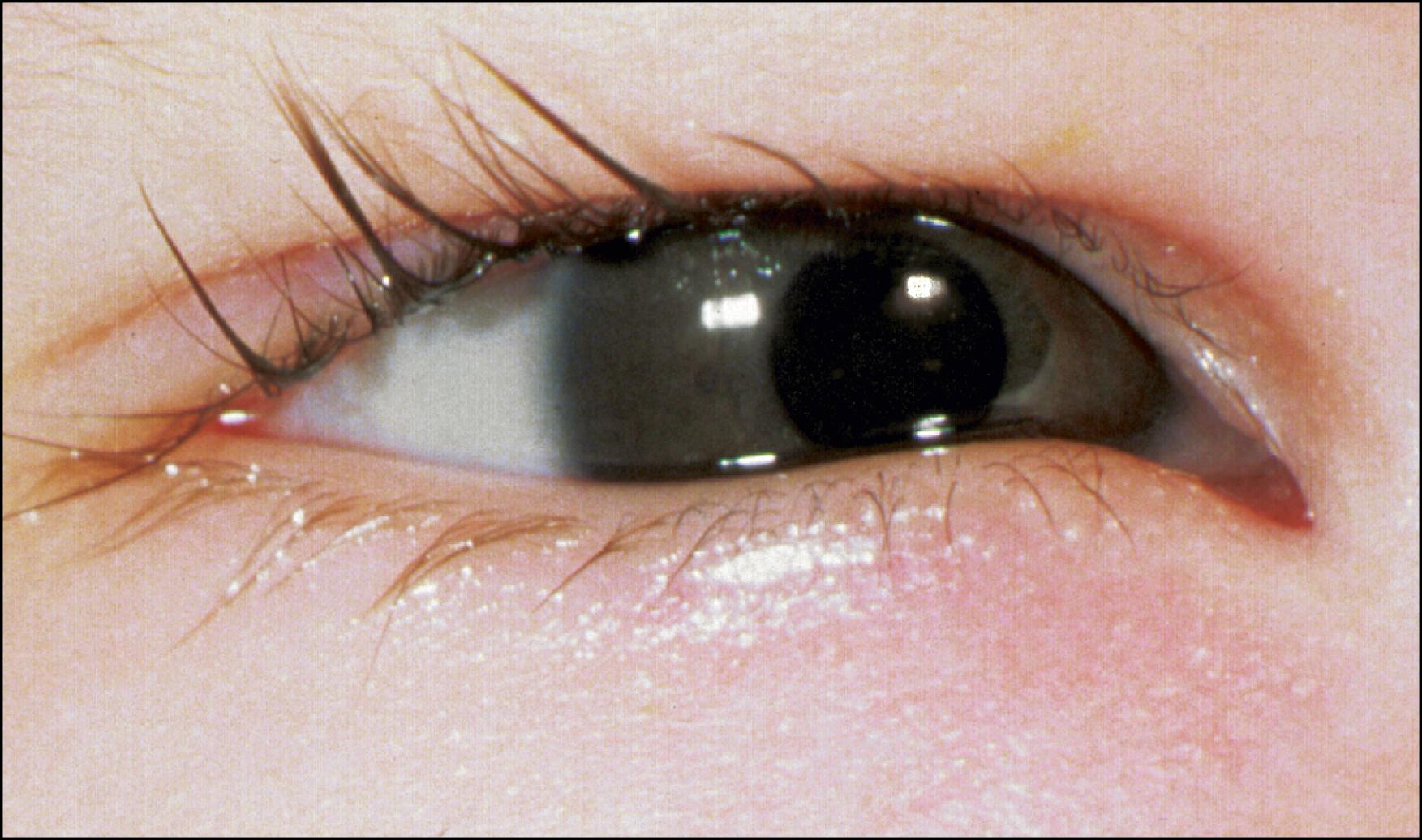
Treatment is surgical excision.
The dermis of the eyelid is composed of loose bundles of collagen, variable amounts of elastic and reticulin fibers, and a ground substance containing mucopolysaccharide. The dermis also contains nerves, blood vessels, smooth muscle, monocytes, histiocytes, and macrophages. Benign dermal lesions may arise from any of the tissue types in the dermis. Lesions are classified and discussed according to their dermal cellular origin.
Neurofibromas (plexiform neurofibroma) may occur as solitary cutaneous lesions or as part of the phakomatosis neurofibromatosis type I (NF-1, von Recklinghausen disease), an autosomal dominant condition in which mutations have been demonstrated in the NF1 gene. Solitary neurofibromas usually occur in adulthood. Multiple cutaneous tumors of neurofibromatosis tend to appear in late childhood or adolescence and gradually increase in size and number. Neurofibromas are soft in consistency, flesh colored, and often pedunculated. Clinical distinction from dermatofibromas and intradermal nevi may be difficult. A plexiform neurofibroma of the upper lid gives a characteristic S-shaped curve to the lid margin and is pathognomonic for NF-1 ( Fig. 27.9 ).
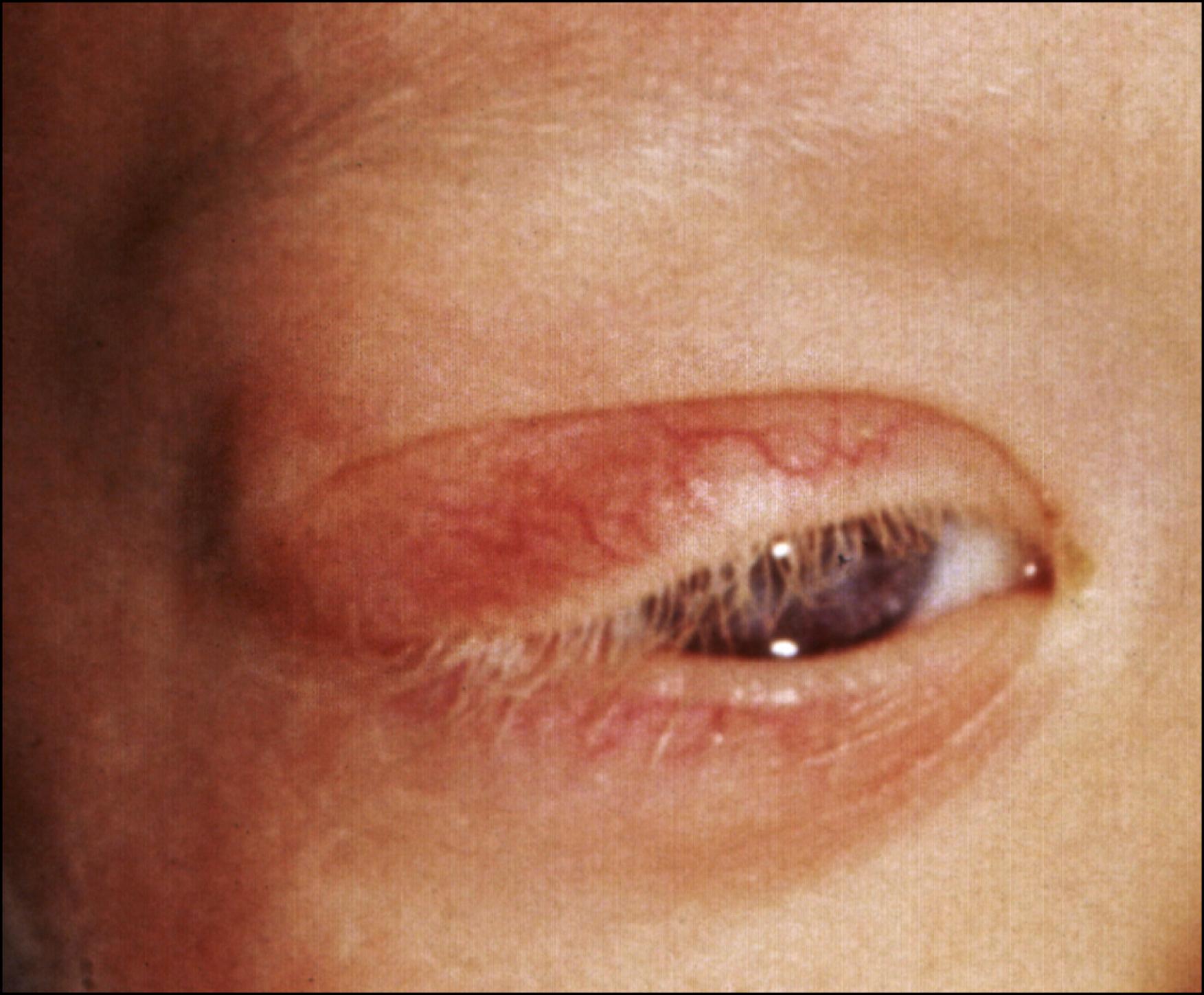
Neurofibromas are tumors resulting from the proliferation of all elements of a peripheral nerve. Histologically, the tumors are poorly circumscribed and composed of spindle-shaped cells embedded in a loose myxoid stroma. This pattern represents a proliferation of Schwann cells and endoneural fibroblasts embedded in collagen. Extension of the tumor outside the perineural sheath is not observed. The tumors may be highly vascularized.
Surgical excision is the recommended treatment when solitary lesions cause mechanical lid distortion (upper lid ptosis or lower lid retraction) leading to visual deprivation or exposure keratitis. Cosmetic deformity and the establishment of a diagnosis are additional indications for excision. The tumors are highly infiltrative; thus complete excision is often not possible without significant sacrifice of adjacent structures. Recurrence is common.
Neurilemomas or schwannomas are derived from Schwann cells of the peripheral nerve sheath. In contrast to neurofibroma, the other components of the peripheral nerve do not proliferate. The lesions are pearly white or yellowish, firm, often painful intradermal nodules. They occur along the course of peripheral nerves. Occurrence in the eyelid is very rare; orbital location is more common. Multiple lesions may be seen in neurofibromatosis type II, an autosomal dominant phakomatosis in which mutations have been identified in the NF2 gene.
Histologically, the tumor appears well circumscribed. The Antoni-A pattern is composed of bundles of elongated cells with thin attenuated nuclei that align themselves into compact parallel rows resembling barrel staves. This arrangement of cells, resembling sensory corpuscles, is referred to as Verocay bodies. The Antoni-B pattern, felt to represent tumor degeneration, appears less dense, with myxoid stromal edema.
Excisional biopsy is necessary to establish the histopathologic diagnosis. Incomplete removal may result in recurrence and more aggressive behavior.
Neuromas are proliferations of nerve fascicles. Occurrence in the eyelid is rare. When part of the autosomal dominant multiple endocrine neoplasia syndrome (MEN type IIb), large numbers of small nodular lesions occur on the skin of the face, nose, and eyelid. Mucosal lesions may occur on the lips, tongue, and mouth. MEN type IIb is also associated with prominent corneal nerves, medullary thyroid carcinoma, and pheochromocytoma; mutations have been identified in the RET proto-oncogene.
Treatment is surgical excision.
Granular cell tumors are rare benign Schwann cell tumors. The lesion is a well-circumscribed, yellow, firm, subcutaneous nodule involving the eyelid or eyebrow of adult patients. Clinical differentiation from other nodular subcutaneous nodules is not possible. Histopathologically, the tumor consists of lobules of oval cells with round nuclei. The cytoplasm is granular and eosinophilic.
Surgical excision is the recommended treatment.
Leiomyomas are benign tumors of smooth muscle origin. Eyelid involvement is rare. The tumor arises from smooth muscle of blood vessels and erector pili muscles. The lesions can be solitary or multiple, pink to brown in color, and may be painful. Differentiation from other nodular subcutaneous lesions based solely on clinical grounds is not possible.
Surgical excision is the recommended treatment.
Become a Clinical Tree membership for Full access and enjoy Unlimited articles
If you are a member. Log in here